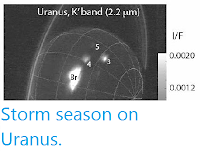Cressida is one of ten small inner moons of the planer Uranus discovered by the Voyager 2 space probe during its January 1986 flyby of the planet. The moon orbits Uranus every eleven hours at an altitude of 61 800 km, and has an average radius of about 41 km, though it is poorly understood, as it is almost impossible to directly observe from Earth.
Voyager 2 image of the Uraniun moons Portia, Cressida and Ophelia. NASA/Wikimedia Commons.
In a paper published on the arXiv database at Cornell University
Library on 24 August 2017, Robert Chancia and Matthew Hedman of the Department of Physics at the University of Idaho, and Richard French of the Astronomy Department at Wellesley College, present an estimation of the mass and density of Cressida based upon its interations with Uranus' η Ring.
The η Ring is one os a system of nine narrow rings around Uranus discovered in 1977 as the occulated (came in front of) the star SAO158687 (the others being the 6, 5, 4, α, β, ε, γ and δ rings). Like the inner moons of Uranus, these rings are extremely hard to observe directly, the η Ring having only been directly imaged twice since it was discovered, both times by the Voyager 2 probe. The ring is estimated to have a core 1-2 km thick surrounded by a more diffuse outer zone about 40 km in radius, and is orbiting the planet at 47 175 km.
However, while these rings are very hard to observe directly, they can be detected when they occulate stars, and while this in itself is a rare event, it is a predictable one. The η Ring has been observed to occulate stars 49 times since its discovery; forty seven times from Earth-based observatories, and twice from Voyager 2. Chancia et al. were able to use these observations to calculate the orbit of the particles within the ring, thereby demonstrating that they were in a 3:2 resonance with the moon Cressida.
An exaggerated cartoon model of ring particle streamlines around a planet and near a 3:2 ILR with an exterior moon, in the co-rotating frame of the moon. The resonant radius is marked with a dashed line and included three ring particle streamlines on either side of the resonance. This shows the stable con guration on either side of the resonance, where a periapse (apoapse) is aligned with the moon interior (exterior) to the resonance. Chancia et al. (2017).
Using this disturbance Chancia et al. calculate the mass of Cressida to be 250 000 000 000 000 000 kilograms. Since the radius of the moon is known and its volume can be calculated from this, then the density can also be calculated, which Chancia et al. calculate at 0.86 grams per square centimetre.(slightly lower than the density of water ice).
See also...
Follow Sciency Thoughts on Facebook.






